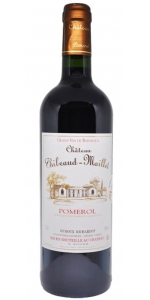Wine from Thibeaud-Maillet

Chateau Thibeaud-Maillet dates back from the French Revolution when the count of Mallet's property was divided into several smaller Estates. It is located in the hamlet of Maillet, North-East of the Pomerol appellation, half a mile away from the Most famous Château in Pomerol (Petrus), sharing the same type of blue clay veins in the soils.
Genevieve Duroux is the fifth generation. She took over the Family property in 2011.
Thibeaud-Maillet Pomerol is made from 100 percent Merlot
Deep ruby with black rim. The nose is spicy, with blackberry, cherry, vanilla, chocolate and a delicate oak presence.
The wine is balanced, the tannins are present, but well integrated and round.
The finish is long and pleasant.
Harvest is done manually and the berries are selected with optical sorting before entering the cellar. Fermentations are carried out at controlled temperature with 3 to 4 weeks of skin contact. Once the malolactic fermentation is completed; the wines are put into barrels (50% new) and aged for 12 months. The estate uses three barrels from three different coopers: Vicard (Charentes)supplying most of the barrels with medium toast and a fine grain, Cadius from Burgundy supplies also fine grain/ medium toasts barrels and last but not least Sylvain, a local cooper is used for three barriques a year, those bring a bit more austerity but also a certain backbone to the blend.
Aged in French oak barrels for 15 months (50% new oak).
Delicious with grilled meat and grilled vegetables.
- back
Selected Options
Wineries
Categories
Pricing
Countries
Regions
Grape Types
Wineries
Organic/Free Shipping
A very deep purple, red in color. This wine showcases Shiraz with its depth of Barossa Valley and the alluring, aromatic freshness of Eden Valley. Vibrant aromas of dark cherries, anise and red raspberry. A distinctive wine with richness and dark berry, fruit compote palate. Perfectly balanced, elegant and refined.
Enjoy with beef filet, roast beetroot and horseradish, or Korean fried cauliflower.
This blend of Barossa Valley (67%) and Eden Valley fruit hails from five parcels averaging 80 years old, the oldest planted in 1854. Intensely concentrated in hue and muscular flavour. Spicy and mineral to the nose and palate, with glimpses of violets. Its iodine and liquorice-edged black cherry and blueberry flavour is succulent, but still in the grip of the sinewy, charry oak, making for an imposing, slightly austere finish. A powerhouse.
Saturated ruby. Heady aromas of ripe dark berries, cherry liqueur, vanilla and incense, with smoky mineral and exotic spice accents building in the glass. Seamless in texture and deeply concentrated, offering palate-staining black and blue fruit, floral pastille and mocha flavors that turn sweeter with air. At once plush and lively, finishing extremely long and smoky, with repeating dark berry and floral notes and velvety tannins.
-Vinous 96 Points
A wine for two seasons. During the winter, heat the wine already infused with spices to enjoy by the fire on a cold evening. Just pop the cork and heat for a nice cozy treat. In the summer, try chilling this wine and add some citrus fruits and apples to create a new favorite sangria recipe.





